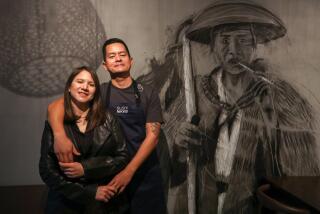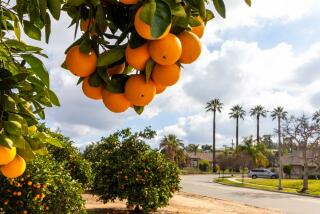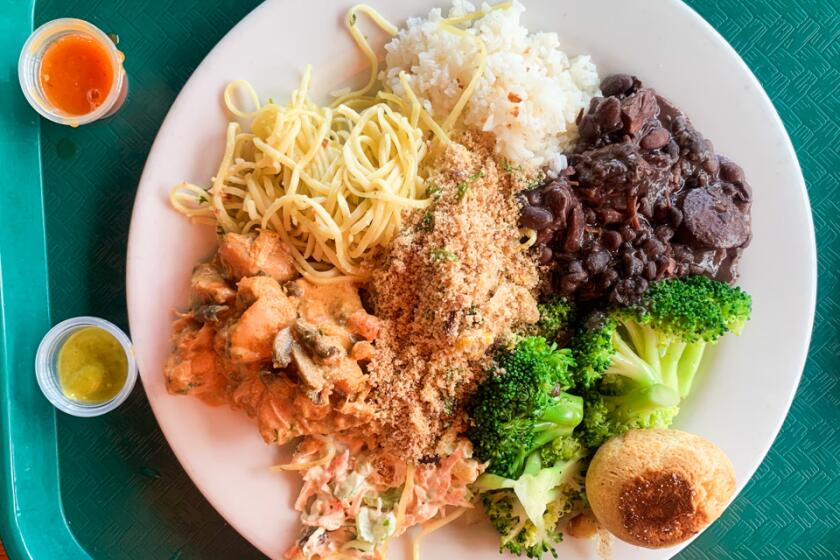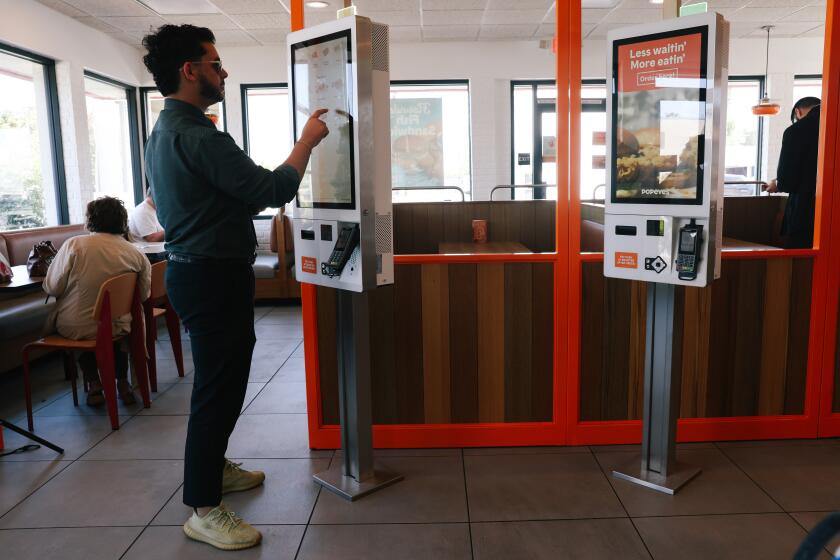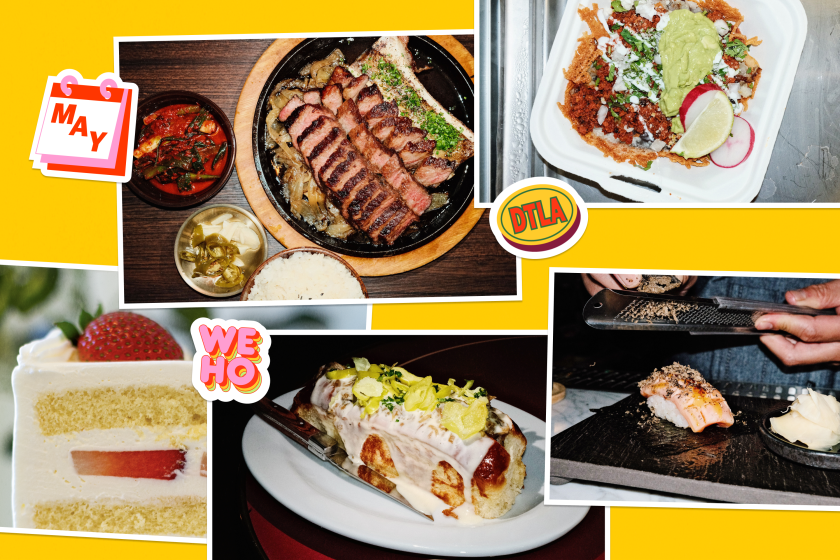The Dekopon arrives in California
I still remember the first time I tasted the legendary fruit the Dekopon. Think of a huge mandarin, easy to peel and seedless, with firm flesh that melts in the mouth, an intense sweetness balanced by refreshing acidity, and a complex, lingering mandarin orange aroma. I’ve tasted more than 1,000 varieties of citrus, and to me the Dekopon is the most delicious.
So delicious, in fact, that I’ve pursued it for more than a dozen years, despite astonishing secrecy and intrigue. But now, finally, the Dekopon is beginning to appear in California stores, and the full story can be told.
The Dekopon, which will be marketed here under the name Sumo, originated in 1972 at a government fruit research station in Nagasaki Prefecture, Japan, as a hybrid of Kiyomi tangor (a cross of orange and satsuma mandarin) and a ponkan, a large mandarin popular in Asia. Initially it seemed unpromising because of its homely appearance, with rough, yellow-orange skin and a distinctive bump at the top. But by the 1990s, as Japanese consumers came to appreciate its rich flavor, Dekopon became the country’s most prized and expensive citrus, fetching as much as $10 apiece.
The variety’s formal name is Shiranui, after a town near Kumamoto, but the prevalent marketing name in Japan is Dekopon, a compound of “deko,” meaning “bump,” and “pon,” for ponkan. In what was widely regarded as a national embarrassment, in 1998 the variety somehow showed up being grown by Japan’s rival, South Korea, where it is now farmed on Jeju island and called Hallabong (after Hallasan, the country’s tallest mountain). It is also cultivated in Brazil, by Japanese immigrants, and in China. To protect United States growers from exotic pests and diseases, however, none of these fruits can be imported into this country.
I first heard about the Dekopon in December 1998 from Brad Stark Jr., a citrus grower in Strathmore, Calif. He was excited because he had imported budwood, branches for grafting new trees, from Japan to a plant quarantine station in Riverside. There, at his expense, scientists of the Citrus Clonal Protection Program used an ingenious technique to cleanse the variety of diseases, in a process that took several years.
Other would-be growers were not so scrupulous. In 2000, plant health authorities discovered that a company had smuggled Dekopon budwood from Japan and used it illegally to propagate 1,078 trees in a grove near Orange Cove in the San Joaquin Valley. This planting was infected with severe strains of tristeza virus, common in Japan, that could have seriously harmed American growers. The Fresno County Agricultural Commissioner fined the company and its principal $26,500, and the orchard was removed and burned.
At least one other group, a Ventura County outpost of a Japanese religious and farming cult, reportedly smuggled Dekopon budwood into California, but the trees derived from it now appear to have been pulled out.
After several years of trying, I finally was able to locate one specimen tree in a scientific collection. The fruit was almost preternaturally flavorful: The membranes around the segments were gossamer thin; the flesh was firm but juicy, almost silky; and it registered so high on my refractometer, an instrument for estimating sugar content, that I first thought the device was broken.
Trying to track down who might be growing the Dekopon, I contacted Stark but learned that his family’s company had gone bankrupt. The precious Dekopon budwood, which had been released from quarantine, was in the custody of a former Stark grower whom I knew, John Fisher of McFarland. But Fisher wouldn’t return my calls, and as I hounded citrus nurserymen and farmers for more information, the Dekopon seemed to remain tantalizingly out of reach.
I’d heard there were trees at the University of California’s budwood orchard at Lindcove, but when I visited in 2006, someone had just cut them down. I knew for the first time the true meaning of the word “stumped.”
Eventually a nurseryman who was well informed about cutting-edge citrus varieties, Roger Smith of TreeSource Citrus Nursery, hinted at what was going on. “I’m not happy that you found out about the Dekopon,” he said, his voice very serious. “Some heavy hitters I work with are interested in it, and [they] would like to have a few years of lead time to grow the trees before everyone else finds out about it.”
Smith feared that if competitors discovered the Dekopon, they could import and clean up the budwood and get started growing the variety. It would be best if I kept quiet about it, he added.
When I pursued the subject, he referred me to his boss, Michael George, general manager of Suntreat Packing & Shipping, but George dodged my calls for three years. Finally, in January 2009, George met with me at his office in Lindsay, 50 miles southeast of Fresno, in the heart of the San Joaquin citrus belt.
He explained that the Griffith family, wealthy former developers in Southern California who own Suntreat and TreeSource, had bought the rights to the legal Dekopon budwood from Stark. He had organized a consortium of 13 growers who had planted 430 acres of Dekopon in local groves, mostly in 2008. All had signed confidentiality and exclusive marketing agreements with Suntreat. No one was supposed to even breathe the word “Dekopon.” If anyone asked, they called the variety of the young trees “XP1.” He expected to market the first crop in 2011.
Now, at last, that harvest has started. Over the past three weeks, I visited several of the orchards, including George’s grove on a hillside in Lindsay. It was a vision out of classic orange crate art, with rows of carefully manicured young trees loaded with fruit, Japanese-style terraces at the upper fringes and a view of snow-capped Sierra peaks to the east.
George, 54, was intense but exhilarated as he surveyed the fruits of his work. He and a marketing manager, Seth Wollenman, had repeatedly visited Dekopon producers in four countries to learn how to grow, pick and pack the variety. For example, although it seemed strange to California growers, the Dekopon needs to be pruned more like a peach tree, to let light in to sweeten the fruit.
Although it looks rugged, the fruit actually has a delicate rind that bruises easily. Normally citrus is harvested into 900-pound bins, but Dekopon pickers use only small hand totes. The bump at the top is especially vulnerable to damage, so in Japan the fruit is packed by hand. That’s too expensive here, said George, so he and his team are adapting a peach-packing line to do the job.
At the beginning of the harvest, the fruit is still so high in acidity that Suntreat uses a secret Japanese storage method to “cure” the fruit, reducing its tartness. But with full maturity, sugar rises and acidity drops naturally: Three weeks ago, Suntreat’s Dekopons already measured 14 degrees Brix (a measure of sugar content), and they should peak at 16 degrees or even 18 degrees later this month, numbers that mean powerhouse flavor. (Typically, other commercial citrus varieties such as navel oranges and clementines average 11 to 13 degrees.) And in a few years, the fruit should taste even better when the trees, now in a juvenile stage, settle down.
The Dekopon’s chief drawbacks are its unlovely looks and its unfamiliar name, which sounds more like an animé monster than a fruit to Westerners. After a painstaking series of focus groups, during which its marketing experts discarded clunkers such as “Tanzilla” and “Tangimodo,” Suntreat settled on the name “Sumo” as evocative of the fruit’s Japanese heritage and imposing size.
The trees, though highly productive, are still so young that this year’s crop is small. Expected to arrive in stores this week, it will mostly be sold in California, at Whole Foods, Grow in Manhattan Beach and more than half a dozen Asian stores such as Mitsuwa and Nijiya markets, for about $3 a pound.
As word of the Dekopon started spreading and other growers expressed an interest in it, California authorities recently re-acquired its budwood for cleanup and release as a publicly available variety. But it will be at least seven years before Suntreat’s competitors begin harvesting their crops.
“I’m cool with that,” says George. “I’m just tickled that we’ve been able to keep it as quiet as we have for so long.”
WHERE TO FIND DEKOPONS
The Dekopons, marketed as Sumo, will be available through March at the stores below. Also see updated listings on the Suntreat Sumo website.
Assi Super. 3525 W. 8th St., Los Angeles, (213) 388-0900
Galleria Market. 3250 W. Olympic Blvd., No. 100, Los Angeles, (323) 733-3800
Greenland Market. 17643 Sherman Way, Van Nuys, (818) 708-7396; 18901 Colima Road, Rowland Heights, (626) 912-1012
Grow. 1830 N. Sepulveda Blvd., Manhattan Beach; (310) 545-2904
HK Market. 831 N. Pacific Ave. Suite A, Glendale; (818) 247-4949
Mitsuwa Marketplace. 665 Paularino Ave., Costa Mesa, (714) 557-6699; 3760 Centinela Ave., Mar Vista, (310) 398-2113; 515 W. Las Tunas Drive, San Gabriel, (626) 457-2899; 21515 Western Ave., Torrance, (310) 782-0335
Nijiya Market. 17869 Colima Road, City of Industry, (626) 913-9991; 124 Japanese Village Plaza Mall, Los Angeles, (213) 680-3280; 2533B Pacific Coast Highway, Torrance, (310) 534-3000; 2121 W. 182nd St., Torrance, (310) 366-7200; 2130 Sawtelle Blvd., No. 105, West Los Angeles, (310) 575-3300
The Plaza Market. 928 S. Western Ave., No. 100, Los Angeles, (213) 385-1100
Whole Foods. 64 stores in California.
Zion Market. 12565 Carson St., Hawaiian Gardens, (562) 865-6600. 4800 Irvine Blvd., Irvine, (714) 832-5600; 3500 W. 6th St., Los Angeles, (213) 351-9900
David Karp
More to Read
Eat your way across L.A.
Get our weekly Tasting Notes newsletter for reviews, news and more.
You may occasionally receive promotional content from the Los Angeles Times.
